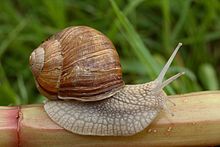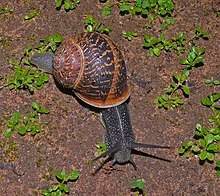Helicidae
| Helicidae | |
|---|---|

| |
| Helix pomatia | |
| Scientific classification | |
| Domain: | Eukaryota |
| Kingdom: | Animalia |
| Phylum: | Mollusca |
| Class: | Gastropoda |
| Order: | Stylommatophora |
| Superfamily: | Helicoidea |
| Family: | Helicidae Rafinesque, 1815 |
| Type genus | |
| Helix | |
| Subfamilies | |
Helicidae is a large, diverse family of small to large, air-breathing land snails, sometimes called the "typical snails."
A number of species in this family are valued as food items, including Cornu aspersum (formerly Helix aspersa) the brown or garden snail, and Helix pomatia the "escargot".[1] The biologies of these two species in particular have been thoroughly studied and documented.
Shell description
The shells of these snails are mostly rather globular in shape. In some genera, such as Cepaea, the shells are brightly colored and patterned.
Anatomy
The animal is capable of complete retraction within the shell. The tail is without a mucous gland or projection.[2][unreliable source?]
The mouth is always provided with a jaw, which is striate, ribbed, sulcate or plicate, sometimes composed of several imbricating pieces. The radula is composed of many transverse horizontal series of teeth, the centrals tricuspidate, about the size of the laterals, laterals bicuspid, or tricuspid with the interior cusp obsolete, marginals usually wider than high, short with two or three small cusps.[2][unreliable source?]
In the soft parts the most obvious distinction is the lack of a caudal mucous pit, and their possessing a sculptured jaw. Typically, there is a distinction in the dentition, although in some species the lateral teeth take on a pseudozonitoid appearance; even in such cases the extreme marginals in Helix remain short and very obtuse.[2][unreliable source?]
This family of snails is defined by the anatomical presence of a diverticulum. Some genera within this family create and use love darts as part of their mating behavior. These snails have one dart apparatus. The dart sac has no accessory sac, and contains two tubular glands, inserted at the base of the dart sac.
In this family, the number of haploid chromosomes lies between 21 and 30 (according to the values in this table).[3]

Distribution
The family is native to Eurasia and belongs the Western Palearctic group.
However some species, notably Cornu aspersum, have been introduced and become established in numerous different areas worldwide.
Many accidental introductions happen because the eggs of most Helicidae are laid in the soil, and they may thus easily travel unnoticed along with landscaping plants.
Genera



The family Helicidae contains 3 subfamilies (according to molecular phylogenetic analyses[4][5][6]):
Subfamily Helicinae Rafinesque, 1815
In this subfamily the glands are divided. The love dart has four blades or vanes. There are usually two penial papillae.
Tribe Allognathini
- Allognathus
- Cepaea Held, 1838
- Hemicycla
- Iberus
- Pseudotachea
Tribe Helicini Rafinesque, 1815
- Assyriella
- Caucasotachea
- Codringtonia
- Helix Linnaeus, 1758 - type genus
- Isaurica
- Levantina
- Lindholmia
- Maltzanella
- Neocrassa
- Tyrrhenaria
Tribe Otalini
- Cantareus Risso, 1826
- Cornu Born, 1778
- Eobania P. Hesse, 1913
- Macularia
- Otala Schumacher, 1817
- Rossmaessleria
- Theba Risso, 1826
Subfamily Murellinae
Tribe Murellini Hesse, 1918
- Marmorana W. Hartmann, 1844 - This genus might actually belong to the subfamily Ariantinae and not to the subfamily Helicinae, as has been assumed until now.[7]
- Tacheocampylaea
- Tyrrheniberus
Subfamily Ariantinae Mörch, 1864
In this subfamily the glands are divided or undivided. The love darts contain two to four blades. There is only one penial papilla.
- Arianta Turton, 1831
- Campylaea H. Beck, 1837
- Campylaeopsis A.J. Wagner, 1914
- Cattania Brusina, 1904
- Causa Schileyko, 1971
- Chilostoma Fitzinger, 1833
- Corneola Held, 1838
- Cylindrus Fitzinger, 1833
- Delphinatia P. Hesse, 1931
- Dinarica Kobelt, 1902
- Drobacia Brusina, 1904
- Faustina Kobelt, 1904
- Helicigona A. Férussac, 1821
- Isognomostoma Fitzinger, 1833
- Josephinella F. Haas, 1936
- Kollarix Groenenberg, Subai & E. Gittenberger, 2016
- Kosicia Brusina, 1904
- Liburnica Kobelt, 1904
- Mesodontopsis Pilsbry, 1895 †
- Metacampylaea Pilsbry, 1895 †
- Paradrobacia H. Nordsieck, 2014 †
- Pseudoklikia H. Nordsieck, 2018 †
- Pseudotrizona Groenenberg, Subai & E. Gittenberger, 2016
- Thiessea Kobelt, 1904
- Vidovicia Brusina, 1904
- †Pseudochloritis C. R. Boettger, 1909[8]
Incertae sedis
References
- ^ M.P. Kerney & R.A.D. Cameron. 1979. A field guide to the land snails of Britain and northwestern Europe. Collins, London.
- ^ a b c Tryon G. W. 1887 Manual of conchology; structural and systematic. With illustrations of the species. Second series: Pulmonata. Volume 3. Helicidae - Volume I. page 3–4.
- ^ Barker G. M.: Gastropods on Land: Phylogeny, Diversity and Adaptive Morphology. in Barker G. M. (ed.): The biology of terrestrial molluscs. CABI Publishing, Oxon, UK, 2001, ISBN 0-85199-318-4. 1-146, cited pages: 139 and 142.
- ^ Korábek, Ondřej; Petrusek, Adam; Neubert, Eike; Juřičková, Lucie (2015-05-01). "Molecular phylogeny of the genus Helix (Pulmonata: Helicidae)". Zoologica Scripta. 44 (3): 263–280. doi:10.1111/zsc.12101. ISSN 1463-6409.
- ^ Razkin, Oihana; Gómez-Moliner, Benjamín Juán; Prieto, Carlos Enrique; Martínez-Ortí, Alberto; Arrébola, José Ramón; Muñoz, Benito; Chueca, Luis Javier; Madeira, María José (2015-02-01). "Molecular phylogeny of the western Palaearctic Helicoidea (Gastropoda, Stylommatophora)". Molecular Phylogenetics and Evolution. 83: 99–117. doi:10.1016/j.ympev.2014.11.014. PMID 25485783.
- ^ Neiber, Marco T.; Hausdorf, Bernhard (2015-12-01). "Molecular phylogeny reveals the polyphyly of the snail genus Cepaea (Gastropoda: Helicidae)". Molecular Phylogenetics and Evolution. 93: 143–149. doi:10.1016/j.ympev.2015.07.022. PMID 26256642.
- ^ Nordsieck H. (2006). Higher classification of Helicoidea and the molecular analyses of their phylogeny. hnords.de, Accessed 20/06/12
- ^ Höltke, Olaf; Rasser, Michael W (2015). "Pseudochloritis insignis–a peculiar large land-snail from the Miocene of SW Germany: taxonomic status and census of morphologically related forms". Journal of Conchology. 42 (1): 1.
